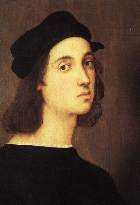|
|
 |
|
Raphael's Stanze at the Vatican |
|
written
by saruw / 09.17.2004 |
|
|
| |
Introduction |
| |
| |

|
| http://mv.vatican.va/3_EN/pages/x-Pano/SDR/Visit_SDR_Main.html |
| Room of the Segnatura |
|
| |
|
| |

|
| http://www.wga.hu/frames-e.html?/bio/r/raphael/biograph.html |
| Raphael's Self Portrait |
| Painting may be found in the Uffizi gallery in Florence, Italy |
| |
|
Raffaello Sanzio (Raphael Santi) was born in Urbino, Italy in 1483 on Good Friday. His father was a mediocre painter who upon Raphael's birth knew of a divine quality that his son possessed. Like the ideal Italian family situation of the day, with two parents and one son, he was raised by his parents in an environment protected from regular peasants and other "less refined" persons. At an early age, his father noticed a strong artistic ability in Raphael, not just the feeling he had at birth, and so he was sent away to study under Pietro Perugino in Perugia. Raphael studied under Perugino and learned to paint duplicates or very similar styles of Perugino's own work. Within a short time, Raphael's abilities as seen through his paintings exceeded that of Perugino's, so he decided to leave and move to Florence, a known hotspot at the time for young and flourishing Renaissance artists.
Once in Florence, Raphael immersed himself amongst the many amazing artists most notably Leonardo da Vinci and Michelangelo. At this time, Raphael continued to grow in his abilities as he dedicatedly researched perspective and form as seen in the art which surrounded him. Much like Michelangelo, he was noted for his depth of research which included the study of his peers both of the present day and of classical times, as well as time spent researching the shape and tone of the human body. Then, at age 25, Raphael was summoned by Bramante, the Pope's architect, to come to the Vatican to tryout to paint for the Pope.
It was at this "tryout" for Pope Julius II, that an unproven Raphael first began work on the Disputa. This became the first painting in a twelve year project that included painting and designing most of the frescoes for the four upstairs Stanze rooms of the Vatican. Within the first few weeks, the Pope's admiration for Raphael's work was so great, he commissioned him to first finish the frescoes of the most famous room, the Segnatura. Upon further completion of the Segnatura, the Pope placed Raphael in charge of the design of the rest of the Stanze, most of which Raphael's students frescoed based upon his designs.
|
| |
|
| |
|
|
 |
|


